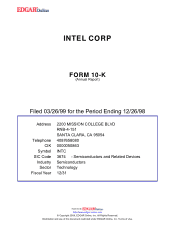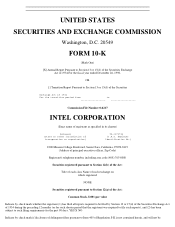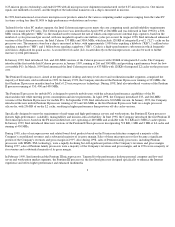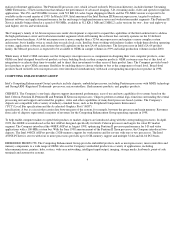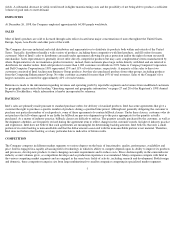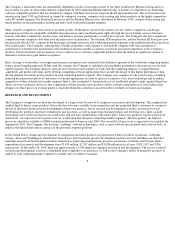Intel 1998 Annual Report Download - page 5
Download and view the complete annual report
Please find page 5 of the 1998 Intel annual report below. You can navigate through the pages in the report by either clicking on the pages listed below, or by using the keyword search tool below to find specific information within the annual report.0.25-micron process technology and ended 1998 with all microprocessor shipments manufactured on the 0.25-micron process. One micron
equals one millionth of a meter, and the length of the individual transistors on a chip is measured in microns.
In 1998, Intel announced several new microprocessor products aimed at the various computing market segments ranging from the value PC
(systems costing less than $1,000) to high-performance workstations and servers.
Tailored for the value PC market segment, the Intel Celeron microprocessor meets the core computing needs and affordability requirements
common to many new PC users. The Celeron processor was introduced in April 1998 at 266 MHz and was followed in June 1998 by a 300-
MHz version. Megahertz ("MHz") is the standard used to measure the rate at which a microprocessor's internal logic operates, based on the
number of cycles processed per second, with one megahertz equal to one million cycles per second. In August 1998, Intel introduced enhanced
versions of the Celeron processor, the Intel Celeron 333 MHz and 300A MHz, which include 128 KB of integrated Level 2 ("L2") cache on the
processor core. The memory stored on a chip is measured in bytes, with approximately 1,000 bytes equaling a kilobyte ("KB"), 1 million bytes
equaling a megabyte ("MB") and 1 billion bytes equaling a gigabyte ("GB"). Cache is a high-speed memory subsystem in which frequently
used data is duplicated for quick access. A second level of cache (L2), located directly on the microprocessor, can also be used to further
increase system performance.
In January 1999, Intel introduced 366- and 400-MHz versions of the Celeron processor with 128 KB of integrated L2 cache. The Company
introduced the first mobile Intel Celeron processor in January 1999, running at 266 and 300 MHz and providing a performance boost for low-
cost mobile PCs. In March, 1999 Intel announced the Intel Celeron processor at 433 MHz with 128KB of integrated L2 cache on the processor
core.
The Pentium II microprocessor, aimed at the performance desktop and entry-level server and workstation market segments, comprised the
majority of Intel units sold worldwide in 1998. In January 1998, the Company introduced the Pentium II processor running at 333 MHz--the
first Pentium II processor manufactured on Intel's 0.25-micron process technology. During 1998, Intel also introduced versions of the Pentium
II processor running at 350, 400 and 450 MHz.
The Pentium II processor for mobile PCs is designed to provide mobile users with the advanced performance capabilities of the P6
microarchitecture while meeting power consumption and size requirements. In April 1998, the Company introduced 233- and 266-MHz
versions of the Pentium II processor for mobile PCs. In September 1998, Intel introduced a 300-MHz version. In January 1999, the Company
introduced the new mobile Pentium II processor running at 333 and 366 MHz as the first Pentium II processor built on a single processor
silicon die, with 256 KB of on-die L2 cache, resulting in higher performance than previous off-die cache versions.
Specifically designed to meet the requirements of mid-range and high-performance servers and workstations, the Pentium II Xeon processor
features high-performance, scalability, manageability and mission-
critical reliability. In June 1998, the Company introduced the first Pentium II
Xeon microprocessor, based on the P6 microarchitecture core, operating at 400 MHz and available with 512 KB and 1 MB L2 cache options.
In January 1999, Intel introduced three new versions of the Pentium II Xeon processor incorporating 512 KB, 1 MB and 2 MB of L2 cache and
running at 450 MHz.
During 1998, sales of microprocessors and related board-level products based on the P6 microarchitecture comprised a majority of the
Company's consolidated revenues and a substantial majority of its gross margin. Sales of these microprocessors first became a significant
portion of the Company's revenues and gross margin in 1997. Also during 1998, sales of Pentium family processors, including Pentium
processors with MMX -TM- technology, were a rapidly declining but still significant portion of the Company's revenues and gross margin.
During 1997, sales of Pentium family processors were a majority of the Company's revenues and gross margin, and in 1996 were a majority of
its revenues and a substantial majority of its gross margin.
In February 1999, Intel introduced the Pentium III microprocessor. Targeted for the performance desktop personal computer and low-end
server and workstation market segments, the Pentium III processor is the first Intel processor designed specifically to enhance the Internet
experience and offers higher performance and enhanced multimedia
3

